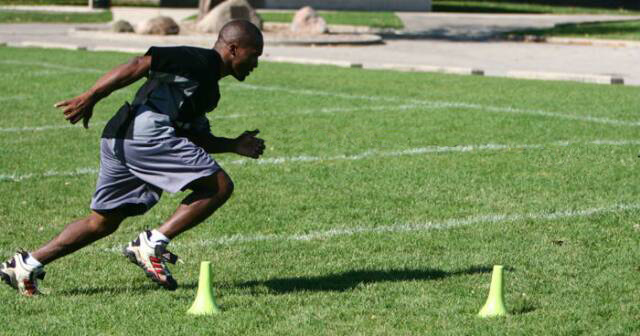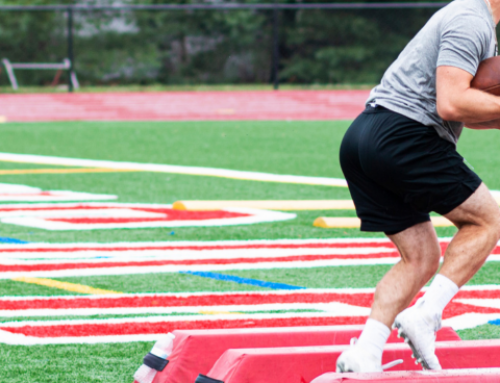Boost Sport-Specific Conditioning With Interval Training

Interval runs are a great way to improve sport-specific conditioning. Instead of jogging a mile at a leisurely pace, which produces slow movement patterns that can hinder power and speed production, try running sprints for different lengths.
One mile equals 1,760 yards. Running four sets of intervals, 12 runs per set at 40 yards each, equals 1,920 yards. So by doing the interval runs, you will sprint more than a mile!
When setting up a metabolic conditioning program, change the distances, running patterns [forward, backward, shuffle] and rest times to simulate your sport. Below are sample programs for basketball and football.
Basketball
Run each interval as fast as possible. Start at the end line of a basketball court.
First Interval
- Sprint to free throw line
- Backpedal back to baseline
- Right shuffle to half court
- Left shuffle back to baseline
- Backpedal to free throw line
- Sprint back to baseline
Rest 20-30 seconds.
Second Interval
- Left shuffle to half court
- Turn and right shuffle to other baseline
- Backpedal full length of court
- Turn and sprint to half court
- Sprint back toward baseline at free throw line
- Turn and backpedal to finish
Rest 20-30 seconds.
Third Interval
- Right shuffle to free throw line
- Turn and sprint to half court line
- Turn and left shuffle to far free throw line
- Turn and sprint to far baseline
- Turn and right shuffle to far free throw line
- Turn and sprint to half court
- Turn and left shuffle to free throw line
- Turn and sprint to start baseline
Set up your own patterns and runs to reflect your team’s style of play–fast break, full-court press, half court pick and roll, or whatever fits the situation.
Football
This series, which can be done on a football field, consists of four sets of 12 sprints. Run each sprint at maximum speed. Walk five yards [about 15 seconds] for active rest.
With a 15-second rest between sprints and a two-minute break between the first and second sets, you will be simulating game conditions. The rest periods equal time between plays, and the two-minute breather mirrors break time between quarters. After two full sets (half time), rest four to five minutes. Then perform your 12 third quarter runs, rest two minutes, and do your final 12 runs for the fourth quarter.
- Sprint five yards; walk five yards
- Sprint 15 yards; walk five yards
- Sprint five yards; walk five yards
- Sprint 10 yards; walk five yards
- Sprint 35 yards; walk five yards
- Turn around—you should have gone 100 yards
- Sprint 30 yards; walk five yards
- Sprint 10 yards; walk five yards
- Sprint five yards; walk five yards
- Sprint 10 yards; walk five yards
- Sprint 10 yards; walk five yards
- Turn around—you should have gone 100 yards
- Sprint 40 yards; walk five yards
- Sprint 30 yards; walk to goal line
Sets/Reps: 4×1; rest 2-3 minutes
When beginning this run series, start with one quarter. As you progress, add a quarter [12 runs] at a time until you can run an entire “game.”
Distances and running patterns—sprinting forward, backpedaling, shuffling—can be tweaked to fit each position. Defensive backs should backpedal with a turn and run; linemen should do shorter runs; and receivers should do longer runs.
By setting up a customized interval training program, you can drive your conditioning to elite levels for your sport.
Photo: viper360trainer.com
RECOMMENDED FOR YOU
MOST POPULAR
Boost Sport-Specific Conditioning With Interval Training

Interval runs are a great way to improve sport-specific conditioning. Instead of jogging a mile at a leisurely pace, which produces slow movement patterns that can hinder power and speed production, try running sprints for different lengths.
One mile equals 1,760 yards. Running four sets of intervals, 12 runs per set at 40 yards each, equals 1,920 yards. So by doing the interval runs, you will sprint more than a mile!
When setting up a metabolic conditioning program, change the distances, running patterns [forward, backward, shuffle] and rest times to simulate your sport. Below are sample programs for basketball and football.
Basketball
Run each interval as fast as possible. Start at the end line of a basketball court.
First Interval
- Sprint to free throw line
- Backpedal back to baseline
- Right shuffle to half court
- Left shuffle back to baseline
- Backpedal to free throw line
- Sprint back to baseline
Rest 20-30 seconds.
Second Interval
- Left shuffle to half court
- Turn and right shuffle to other baseline
- Backpedal full length of court
- Turn and sprint to half court
- Sprint back toward baseline at free throw line
- Turn and backpedal to finish
Rest 20-30 seconds.
Third Interval
- Right shuffle to free throw line
- Turn and sprint to half court line
- Turn and left shuffle to far free throw line
- Turn and sprint to far baseline
- Turn and right shuffle to far free throw line
- Turn and sprint to half court
- Turn and left shuffle to free throw line
- Turn and sprint to start baseline
Set up your own patterns and runs to reflect your team’s style of play–fast break, full-court press, half court pick and roll, or whatever fits the situation.
Football
This series, which can be done on a football field, consists of four sets of 12 sprints. Run each sprint at maximum speed. Walk five yards [about 15 seconds] for active rest.
With a 15-second rest between sprints and a two-minute break between the first and second sets, you will be simulating game conditions. The rest periods equal time between plays, and the two-minute breather mirrors break time between quarters. After two full sets (half time), rest four to five minutes. Then perform your 12 third quarter runs, rest two minutes, and do your final 12 runs for the fourth quarter.
- Sprint five yards; walk five yards
- Sprint 15 yards; walk five yards
- Sprint five yards; walk five yards
- Sprint 10 yards; walk five yards
- Sprint 35 yards; walk five yards
- Turn around—you should have gone 100 yards
- Sprint 30 yards; walk five yards
- Sprint 10 yards; walk five yards
- Sprint five yards; walk five yards
- Sprint 10 yards; walk five yards
- Sprint 10 yards; walk five yards
- Turn around—you should have gone 100 yards
- Sprint 40 yards; walk five yards
- Sprint 30 yards; walk to goal line
Sets/Reps: 4×1; rest 2-3 minutes
When beginning this run series, start with one quarter. As you progress, add a quarter [12 runs] at a time until you can run an entire “game.”
Distances and running patterns—sprinting forward, backpedaling, shuffling—can be tweaked to fit each position. Defensive backs should backpedal with a turn and run; linemen should do shorter runs; and receivers should do longer runs.
By setting up a customized interval training program, you can drive your conditioning to elite levels for your sport.
Photo: viper360trainer.com










